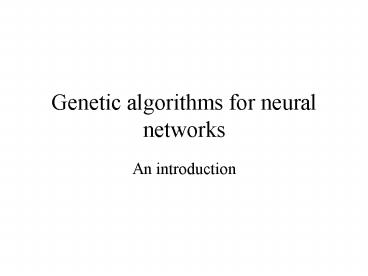Genetic algorithms for neural networks - PowerPoint PPT Presentation
Title:
Genetic algorithms for neural networks
Description:
Using genetic algorithms with neural networks. Why use genetic algorithms? ... Roulette wheel algorithm. Genes are crossed over between parents [x11, x12, x13, x14] ... – PowerPoint PPT presentation
Number of Views:111
Avg rating:3.0/5.0
Title: Genetic algorithms for neural networks
1
Genetic algorithms for neural networks
- An introduction
2
Genetic algorithms
- Why use genetic algorithms?
- What arent genetic algorithms?
- What are genetic algorithms?
- What to avoid
- Using genetic algorithms with neural networks
3
Why use genetic algorithms?
4
What arent genetic algorithms?
- Hill-climbing algorithms
- Enumerative algorithms
- Random searches
- Guesses
- Ask an expert
- Educated guesses
5
Hill-climbing
- Calculus based approach
6
But
?
?
7
But
?
?
?
?
?
?
8
More realistically?
?
?
?
?
?
?
?
?
?
?
- Noisy?
- Discontinuous?
?
?
9
Robust scheme
10
Genetic algorithms
- Cope with non-linear functions
- Cope with large numbers of variables efficiently
- Cope with modelling uncertainties
- Do not require knowledge of the function
11
What are genetic algorithms?
12
Circle of life
13
Chromosome
- A collection of genes
- xi1, xi2, xi3, xi4,
14
Fitness
- Ranked by a fitness factor
- Proportional to the likelihood of breeding
- Action of the algorithm is to maximise fitness
15
Breeding and crossover
- Parents selected randomly with a probability
proportional to fitness - Roulette wheel algorithm
- Genes are crossed over between parents
- x11, x12, x13, x14
- x21, x22, x23, x24
16
Mutation
- Small (random) variation in a gene
- xi1, xi2, xi3, xi4 --gt xi1, xi2, xi3?, xi4
17
Circle of life
Good
Bad
18
Genetic algorithms
- Work on populations, not single points
- Use an objective function (fitness) only, rather
than derivatives or other information - Use probabilistic rules rather than deterministic
rules - Operate on an encoded set of values (a
chromosome) rather than the values themselves
19
Potential problems
- GA deceptive functions
- Premature and postmature convergence
- Excessive mutation
- Application to constrained problems
- Neural networks, particularly
- The meaning of fitness
20
Deceptive functions and premature convergence
- A function which selects for one gene when a
combination would be better - Can eliminate better genes
- Avoided by
- Elitism
- Multiple populations
- Mutation (which reintroduces genes)
- Fitness scaling
21
Postmature convergence
- When all of a population performs well, selection
pressures wane - Avoided by fitness scaling (be careful!)
22
Excessive mutation
- Too little mutation loss of genes
- Too much mutation random walk
23
Application to constrained problems
- Neural networks and genetic algorithms are by
nature unconstrained - i.e they can take any value
- Must avoid unphysical values
- Restrict mutation
- Punish through fitness function
24
The meaning of fitness
- Genetic algorithms maximise fitness
- Therefore fitness must be carefully defined
- What are you actually trying to do?
25
When to stop?
- How long do we run the algorithm for?
- Until we find a solution
- Until a fixed number of generations has been
produced - Until there is no further improvement
- Until we run out of time or money?
26
Genetic algorithms for Bayesian neural networks
- Generally want to find an optimised input set for
a particular defined output
27
Define fitness
- Need a function that includes target and
uncertainty
28
Define the chromosome
- Set of inputs to the network except
- Derived inputs must be removed
- e.g. if you have both t and ln(t), or T and
exp(-1/T), only one can be included - Prevents unphysical input sets being found
29
Create the populations
- Chromosomes are randomly generated
- (avoid non-physical values)
- Population size must be considered
- 20 is a good start
- Best to use more than one population
- Trade-off between coverage and time
- Three is good
30
Run the algorithm!
- Decode chromosomes to NN inputs (i.e. calculate
any other inputs) - Make predictions for each chromosome
- if the target is met or enough generations have
happened, stop - Calculate fitness for each chromosome
- Preserve the best chromosome (elitism)
- Breed 18 new chromosomes by crossbreeding
- Mutate one (non-elite) gene at random
- Create new chromosome at random
- Go back to 1































